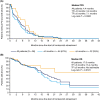Bortezomib retreatment for relapsed and refractory multiple myeloma in real-world clinical practice
- PMID: 30697597
- PMCID: PMC6346989
- DOI: 10.1002/hsr2.104
Bortezomib retreatment for relapsed and refractory multiple myeloma in real-world clinical practice
Abstract
Aims: Studies have shown that bortezomib retreatment is effective in relapsed/refractory multiple myeloma (MM). The observational, prospective electronic VELCADE® OBservational Study (eVOBS) study assessed bortezomib-based therapies for patients with MM in everyday practice. Here, we report on those patients receiving retreatment with bortezomib.
Methods: Consenting adults scheduled to receive bortezomib for MM were enrolled at 162 sites across Europe, Canada, Brazil, Russia, and Turkey between 2006 and 2010. Retrospective data on prior therapies and prospective observational data after bortezomib initiation were captured electronically at baseline, after every bortezomib cycle, and every 12 weeks after discontinuation or progression. Investigator-assessed responses and adverse events (AEs) were evaluated.
Results: Ninety-six of 873 patients enrolled to eVOBS received bortezomib as first retreatment for progressive disease during the prospective observation period. Median age was 62 years, 53% were male, and median number of prior therapies at retreatment was 4. Overall, 41% of patients initiated bortezomib retreatment in combination with dexamethasone, 16% in combination with lenalidomide, and 21% received monotherapy. Rate of partial response or better (≥PR) was 75% at initial bortezomib therapy, including 44% complete response (CR)/near CR (nCR); at retreatment, ≥PR rate was 46%, including 15% CR/nCR. Median progression-free survival was 11.4 months (95% confidence interval [CI]: 9.1-12.7) from start of initial bortezomib treatment and 6.4 months (95% CI: 4.4-7.2) from start of retreatment. Median overall survival from start of retreatment was 17.6 months (95% CI: 14.4-23.5). Of the 96 patients retreated with bortezomib, 77% reported an AE. Peripheral neuropathy during bortezomib retreatment occurred in 49% of patients, including 10% grade 3/4.
Conclusion: These data suggest that retreatment with bortezomib is a feasible option for patients with relapsed/refractory MM.
Keywords: multiple myeloma; real world; refractory; relapsed; retreatment.
Figures




References
-
- Suzuki K. Current therapeutic strategy for multiple myeloma. Jpn J Clin Oncol. 2013;43(2):116‐124. - PubMed
-
- Kumar SK, Therneau TM, Gertz MA, et al. Clinical course of patients with relapsed multiple myeloma. Mayo Clin Proc. 2004;79(7):867‐874. - PubMed
-
- Offidani M, Corvatta L, Morabito F, et al. How to treat patients with relapsed/refractory multiple myeloma: evidence‐based information and opinions. Expert Opin Investig Drugs. 2011;20(6):779‐793. - PubMed
-
- Dimopoulos MA, Terpos E. Multiple myeloma. Ann Oncol. 2010;21(Suppl 7):vii143‐vii150. - PubMed
-
- Mohty B, El‐Cheikh J, Yakoub‐Agha I, et al. Treatment strategies in relapsed and refractory multiple myeloma: a focus on drug sequencing and ‘retreatment’ approaches in the era of novel agents. Leukemia. 2012;26(1):73‐85. - PubMed
LinkOut - more resources
Full Text Sources
Research Materials

